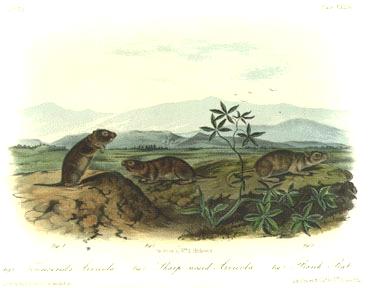

144 Townsend's Arvicola
ARVICOLA TOWNSENDII.--BACH.
[Microtus townsendii]
TOWNSEND'S ARVICOLA.
[Townsend's Vole]
PLATE CXLIV. FIG. I.--MALE.
A. Mure decumano duplo minor, auriculis erectis, vellere prominulis, colore
in dorso plumbeo ad rufum vergente in capite colloque.
CHARACTERS.
Half the size of the Norway rat; ears, upright, and visible beyond the fur;
Plumbeous on the back, inclining to rufous on the head and neck.
SYNONYME.
ARVICOLA TOWNSENDII. Bachman, Jour. Acad. Nat. Sciences, vol. viii.,
part 1, p. 60.
DESCRIPTION.
Body, cylindrical; head, rather small; whiskers, long, reaching beyond the
ears; eyes, small; teeth, large; ears, large, broad, erect, extending
considerably above the fur; feet, of moderate size; toes, like the rest of this
genus; thumb, protected by a rather short acute nail; tail, scaly, sparingly
covered with soft hair, a few hairs at its extremity; feet, clothed to the nails
with short brown adpressed hairs; fur, on the back, about three lines long, much
shorter beneath.
COLOUR.
Whiskers, white and black; teeth, yellow; fur on the upper part of the
body, lead colour from the roots to near the tips, which present a mixture of
white and black points, from which results a general plumbeous colour; under
surface, grayish-ash; neck, sides of face, nose, and an obscure line above the
eye, ashy-brown; tail, brownish, with a few white hairs at the tip; feet,
yellowish-brown; claws, brown.
DIMENSIONS.
Inches. Lines.
Length of head and body, . . . . . 6 0
Tail,. . . . . . . . . . . . 2 6
Fore-feet to point of nails, . . . . 0 9
Heel to point of nail, . . . . . . 1 0
Breadth of ear, . . . . . . . . 0 5
HABITS.
The late Mr. TOWNSEND, who captured this animal under an old log on the
banks of the Columbia river, gave us no account of its habits. We should judge
from its form, its conspicuous ears, and its general resemblance to the cotton
rat of Carolina (Sigmodon hispidum), that it possesses many of its
characteristics. It was found in the woods, but we imagine that it exists on
the edges of the open country skirting the forests, feeding on roots, grasses,
and seeds, nesting under logs and brushwood, and having, like the rest of the
genus, four or five young at a birth.
GEOGRAPHICAL DISTRIBUTION.
The specimen here described was obtained on the 21st of July, 1835, by Mr.
TOWNSEND, on the shores of the Columbia river. It no doubt is widely
distributed on the western side of the Rocky Mountains, and replaces the
Wilson's Meadow-Mouse of our northern Atlantic States.
GENERAL REMARKS.
We find it exceedingly difficult to ascertain characters to designate the
various species of Arvicolae in our country; they resemble each other in many
particulars, and especially in colour. We can however find no description which
answers to this species in RICHARDSON or any other author.
|